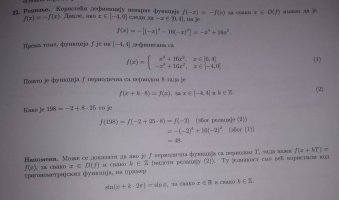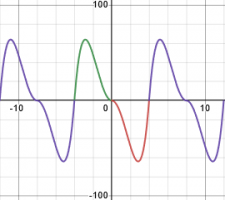Problem formulation:
If function f is odd with period 8 and if f(x) = x^4 - 16x^2, for x belonging to the interval [0,4], then what does f(198) equal to ?
The text clearly elicits assignment of the following equation as the starting step: f(-x) = f(x) ( since the function is said to be odd ).
However, the official solution now says that from the foregoing equation, it can be deduced that f(x) = -f(x). How they mathematically come from f(-x) = f(x) to this, is beyond me.
It now says the following: If x is an element of the interval [-4,0], it follows that -x is an element of the interval [0,4].
I don't understand how they come to x being an element of [-4,0] at the first place ! I would conclude that -x is an element of [-4,0] ( opposite sign of the domain that stands for x, obviously ).
Now, based on the equation of parity ( the basic one, f(-x) = f(x) ) and the f(x) definition given in the text of the problem, we have:
[math]f(x) = -((x)^4 - 16(-x)^2) = -x^4 + 16x^2[/math]
Now comes the most confusing part. I will cite the official solution.
On the interval [-4,4], function f is thus defined with:
f(x) = { x^4 + 16x^2, x element of [0,4]
{ -x^4 + 16x^2, x element of [-4,0]
( the beginning braces should be fused into one, designating ''branching'' of the same function )
Regardless of whether -x is of the interval I expressed confusion about or not, the first equation just cannot make sense to me.
Whether the input x is positive or negative, since the 2 variables in the function definition are put to power of an even number, the equation CANNOT change in sign, and thus has to be even. This doesn't make sense even considering the beginning premises of the problem !
Either way, if we ignore that for some reason, we can only have
[math]f(x) = x^4 - 16x^2[/math]
or
[math]f(x) = -x^4 + 16x^2[/math]
( depending on whether we just repeat the definition of f(x) or use the equation f(x) = -f(x) )
I do notice my reason has to be wrong as it leads to refutation of the initial premises ( and ultimately ends nowhere ), but I don't exactly understand where and how !
I would be immensely thankful if anybody could help me with clarification of this issue. Thank you in advance.
If function f is odd with period 8 and if f(x) = x^4 - 16x^2, for x belonging to the interval [0,4], then what does f(198) equal to ?
The text clearly elicits assignment of the following equation as the starting step: f(-x) = f(x) ( since the function is said to be odd ).
However, the official solution now says that from the foregoing equation, it can be deduced that f(x) = -f(x). How they mathematically come from f(-x) = f(x) to this, is beyond me.
It now says the following: If x is an element of the interval [-4,0], it follows that -x is an element of the interval [0,4].
I don't understand how they come to x being an element of [-4,0] at the first place ! I would conclude that -x is an element of [-4,0] ( opposite sign of the domain that stands for x, obviously ).
Now, based on the equation of parity ( the basic one, f(-x) = f(x) ) and the f(x) definition given in the text of the problem, we have:
[math]f(x) = -((x)^4 - 16(-x)^2) = -x^4 + 16x^2[/math]
Now comes the most confusing part. I will cite the official solution.
On the interval [-4,4], function f is thus defined with:
f(x) = { x^4 + 16x^2, x element of [0,4]
{ -x^4 + 16x^2, x element of [-4,0]
( the beginning braces should be fused into one, designating ''branching'' of the same function )
Regardless of whether -x is of the interval I expressed confusion about or not, the first equation just cannot make sense to me.
Whether the input x is positive or negative, since the 2 variables in the function definition are put to power of an even number, the equation CANNOT change in sign, and thus has to be even. This doesn't make sense even considering the beginning premises of the problem !
Either way, if we ignore that for some reason, we can only have
[math]f(x) = x^4 - 16x^2[/math]
or
[math]f(x) = -x^4 + 16x^2[/math]
( depending on whether we just repeat the definition of f(x) or use the equation f(x) = -f(x) )
I do notice my reason has to be wrong as it leads to refutation of the initial premises ( and ultimately ends nowhere ), but I don't exactly understand where and how !
I would be immensely thankful if anybody could help me with clarification of this issue. Thank you in advance.




